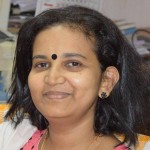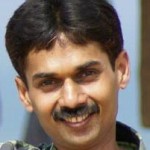 Salini Sreenivasan
Salini Sreenivasan
In times when seasons play passive-aggressive mind games with our days, it is hard to readily form associations between festivals and seasons. Despite this, the mood in Kerala changes post the South-West monsoon, whether it chooses to arrive or not, with several festivals of a comparatively new make-up sprouting a new-found crowd of enthusiasts with the focus mostly on cultural gatherings where culture consists of texts that include literature, theatre, art, cinema and the performing arts, with annual events like the Hay Festival, Soorya Festival and several others culminating with the IFFK (International Film Festival of Kerala) in mid-December. Thiruvananthapuram has had the pleasure of hosting many stalwarts like Germaine Greer at the Hay Festival last year and who can forget the surprise Sting the year before that. We are in the middle of the season of culture this year with the Kovalam Literary Festival already behind us and anticipations for the Hay Festival running high.
As cultural festivals go, the Kovalam Literary Festival offers all the necessary ingredients, the fever and excitement of good entertainment that is food to the brain, exposure and an opportunity to touch people who are legends in their respective arenas. Beyond this apparent hype, it has also offered a platform where writers, intellectuals and activists can find common ground and engage in pertinent discussions on their preoccupations with our society and the art that reflects it. This is the place where Binayak Sens meet Benyamins and an ambitious people of a small town get to watch this union.
This year’s schedule started with a first leg in New Delhi on October 3rd. The one-day-spread included readings and discussions with writers from home and abroad including Jeet Thayil, David Davidar, Monisha Rajesh, Dorit Rabinyan, Sarai Shavit, Roderick Mathews, Farrukh Dhondy, Nilanjana Roy and Ru Freeman. An interesting feature of the festival has been this element of discussion where the reader gets the opportunity not only to experience the text in a close to first hand way with the writer herself narrating/ presenting it and but also to see the author in conversation with another reader whose experience with the text, among other things, are discussed to reveal with ease several planes through which to approach the text.
This was especially true when the second leg of the festival took off at Kanakakkunnu Palace, Thiruvananthapuram on October 6th with the fifth annual K.C. John Memorial Lecture delivered by Dr. Binayak Sen whose continuing exposition of the play of politics behind agricultural policies has been a succinct example of how the gap between theoretical knowledge and activism can be effectively bridged. The event went beyond the boundaries of an informative lecture when the discussion entitled “Are the Poor Getting Poorer” that followed with Dr. Ilina Sen and human rights activist Vrinda Grover raised concerns on energy economics and a call for action from Ms/Dr. Sen for the transformation of food security to food sovereignty. The imminent threat of famine due to skewed agricultural policies predicted by Dr. Binayak Sen thus found suggestions of solutions in the discussions that followed, once more stressing the importance of dialogue in the democratic process. Kovalam Literary Festival, in its opening event itself proved that its range went far beyond purely literary concerns making it a festival that is multidisciplinary in its attire and attitude.
Other events on the first day of the two-day festival may have had a purely literary outlook but the books and the authors who formed the vortex of discussion were far from the confines of that tag. The inaugural lecture was followed by a session on the evolving Indian novel where Farrukh Dhondy, Timeri Murari, N.S. Madhavan, Nilanjana Roy and C.P. Surendran anchored by journalist Suresh Menon discussed the usual questions concerning writing and publishing in a world that is governed by media of other forms and increasingly alienated from the written word. The participants, being writers themselves, were concerned about the process of writing, the absence of the anxiety of influence and inspiration and what constitutes Indian Writing. While Dhondy was concerned about the dearth of models of good writing for Indian writers in English, N.S. Madhavan, with his primary works in Malayalam, raised the question of whether the literature in the vernacular tongues of India would qualify for Indian Writing as it is conceived now in the literary world and could the term be employed as an umbrella term taking into consideration only the geographical entity that is India. Madhavan also directed attention to the gradual transformation of the writer of literature into a journalist, a commentator on reality forced to comment on all contemporary issues and accepting this as part of the social responsibility of a cultural figure. The sessions also included readings by the participating authors. Nilanjana Roy read passages from her debut novel The Wildings, where the world of fantasy becomes that of the real and the animal transcends the tag of the anthropomorphic; Murari from his new work The Taliban Cricket Club that plays on the sub-continent’s obsession with the sport in the face of ideological struggles and C P Surendran from his novel Lost and Found where the narrative of a city in the prelude to a terrorist attack exudes the high of a series of interconnected teeming stories.
Day one also saw the release of Biman Nath’s new book, The Tattooed Fakir, a work of historical fiction and later, a discussion without which no festival with its focus on Indian Writing in English would be complete, a talk with Naresh Fernandes, the author of Taj Mahal FoxTrot, on Colonial India in Indian writing, Aroon Raman’s thoughts on thriller as an Indian genre that tried to reclaim the genre’s affinity to the Indian psyche through associations with its significance in traditional Indian narratives, Roderick Mathews in conversation with Farrukh Dhondy and N.S. Madhavan reading from Litanies of Dutch Battery and Ru Freeman reading from Disobedient Girl.
The morning session of the concluding day opened the arena for female players to flex their muscles. The first two sessions had authors Sonia Faleiro and Nilanjana Roy reading from their new works and later engaging in conversation with other women writers/critics. Faleiro’s The Beautiful Thing is an insightful work of non-fiction that combines the meticulousness of a master-journalist and the charisma of a novelist in bringing to life the secret world of Mumbai’s bar dancers. With this work, Indian narrative journalism takes a turn for the better. The discussions that followed the readings exposed the concerns of unique women who strive to embark on a journey of new realities and perhaps better ways of telling existing realities beyond the framework of traditional narrative structure.
No festival which aspires to the epithet of the “cultural” can hope to support its claims if it confines itself to the literary text and its preoccupations. The afternoon session on the concluding day had the KLF’s attempts at achieving a multi-art schedule with renowned photographer Amit Pasricha’s presentation entitled the Panorama in Indian Photography. The presentation was a revelation in Indian geography: cultural, emotional as well as physical. Once exposed to his photographs one is sure to feel that any other mode except the panoramic would be inadequate to capture the sheer mythical proportion of the Indian visual, be it on any plane.
The focus of the festival returned to the literary soon with a session on Mumbai as the city of Indian imagination where Naresh Fernandes, Sonia Faleiro, and Farrukh Dhondy moderated by C. P. Surendran, thrashed out their views on the commercial capital of the country. They parted ways without reaching an agreement on the destiny of the tinsel town, the city of dreams, but for the audience it was nevertheless a fruitful and opportune conversation on a city that has perhaps been at the centre of Indian English writing, beginning with Midnight’s Children and stretching out to the latest contender for Booker, Narcopolis, the much-celebrated debut from Jeet Thayil.
The festival did not let the vernacular down; it made some space for discussion on the literature of the host state which has been accused countless times of dying a slow and putrid death, producing nothing but frail attempts at greatness, mere delusions of grandeur. A breath of fresh air came in 2008 with Aadujeevitham, a work that catapulted its author, Benyamin to instant celebrity and gave a new lease of life to the struggling vernacular literature. In a session moderated by journalist Sabin Iqbal, noted author N.S. Madhavan and an unscheduled addition, the haloed Benyamin himself, read out from their works, Litanies of Dutch Battery and Goat Days respectively, newly translated into English. It was also an occasion for unbridled praise from a stalwart to a newcomer with Madhavan saying “Benyamin comes like spring thunder over a summer sky in the arid landscape of Malayalam literature; his writing is a sign that we are finding our feet again".
Indian Ocean, perhaps the first Indian fusion band, adorned the festival with a fitting end, mesmerising the audience with a wonderful performance. Giving company to the many of his compatriot writers who had found their way to this corner of the world this year, the one-man-band from Israel, Tal Kravitz also entertained while providing a delectable fare that was certainly fresh for the average Malayalee palette.
The Kovalam Literary Festival concluded with hope; five years since its inception, the festival has managed to break elitist tags, include the vernacular in its itinerary and sport a welcoming fare altogether, becoming one more event, one more festival that the human being post global warming can look forward to with both sweet anticipation and comforting certainty.





